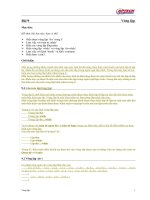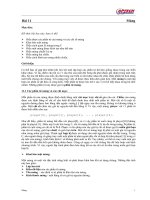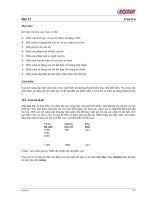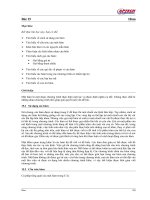Computer concept 2018 module07
Bạn đang xem bản rút gọn của tài liệu. Xem và tải ngay bản đầy đủ của tài liệu tại đây (3.03 MB, 90 trang )
Computer Concepts 2018
Module 7
Digital Security
Copyright © 2019 Cengage. All rights reserved.
Module Contents
•
•
•
•
•
Section A: Basic Security
Section B: Malware
Section C: Online Intrusions
Section D: Interception
Section E: Social Engineering
© 2019 Cengage. All rights reserved.
Section A: Unauthorized Use
•
•
•
•
Encryption
Authentication
Passwords
Password Managers
© 2019 Cengage. All rights reserved.
Section A: Objectives (1 of 2)
• List five examples in which digital data is encrypted for
security purposes
• Describe how two-factor authentication works when you
log in to a Gmail account from a device you have never
used before
• Explain how encryption is linked to passcodes in some
digital devices
• Describe the advantages of encrypting an entire storage
volume
• Recite the basic rules for creating a strong password
© 2019 Cengage. All rights reserved.
Section A: Objectives (2 of 2)
• List at least five characteristics of weak passwords
• Recite the formula for calculating the number of
possible passwords that can be generated using a fourdigit PIN
• Explain the concept of password entropy
• Describe the advantages and disadvantages of local,
cloud-based, and USB password managers
© 2019 Cengage. All rights reserved.
Encryption (1 of 3)
• Encryption transforms a message or data file in such a
way that its contents are hidden from unauthorized
readers
• An original message or file that has not yet been
encrypted is referred to as plaintext or cleartext
• An encrypted message or file is referred to as
ciphertext
• The process of converting plaintext into ciphertext is
called encryption; the reverse process—converting
ciphertext into plaintext—is called decryption
© 2019 Cengage. All rights reserved.
Encryption (2 of 3)
• Data is encrypted by using a cryptographic algorithm
and a key
– A cryptographic algorithm is a procedure for encryption
or decryption
– A cryptographic key (usually just called a key) is a word,
number, or phrase that must be known to encrypt or
decrypt data
•
There are various encryption methods, and some are
more secure than others; AES (Advanced Encryption
Standard) is the encryption standard currently used
worldwide
© 2019 Cengage. All rights reserved.
Encryption (3 of 3)
© 2019 Cengage. All rights reserved.
Authentication (1 of 4)
• Authentication protocols, such as passwords, PINs,
and fingerprint scans and facial recognition are the first
line of defense against data thieves and snoopers
• iPhones and iPads should be configured to require a
login password, called a passcode, each time the
device is used; the standard iOS security setting
establishes a four-digit numeric passcode, similar to a
PIN (personal identification number)
© 2019 Cengage. All rights reserved.
Authentication (2 of 4)
• Android devices have an overwhelming number of
security settings; Android devices do not automatically
encrypt data stored on the device when a user activates
the login password; configuring a password and
activating encryption are two separate steps
© 2019 Cengage. All rights reserved.
Authentication (3 of 4)
© 2019 Cengage. All rights reserved.
Authentication (4 of 4)
• Windows offers several password options that can be
configured using the Accounts utility, which is accessed
from the Start menu or Control panel; Windows devices
can be encrypted using Microsoft’s BitLocker or thirdparty utilities
• Macs offer several password settings, which are
accessed from the Security & Privacy preferences; a
feature called Automatic Login allows access to a
device without a password
© 2019 Cengage. All rights reserved.
Strong Passwords (1 of 10)
• A strong password is difficult to hack; conventional
wisdom tells us that strong passwords are at least eight
characters in length and include one or more uppercase
letters, numbers, and symbols
© 2019 Cengage. All rights reserved.
Strong Passwords (2 of 10)
• A brute force attack uses password-cracking software
to generate every possible combination of letters,
numerals, and symbols. Because it exhausts all
possible combinations to discover a password, it can
run for days before a password is cracked
• A dictionary attack helps hackers guess your
password by stepping through a dictionary containing
word lists in common languages such as English,
Spanish, French, and German
© 2019 Cengage. All rights reserved.
Strong Passwords (3 of 10)
•
Dictionary attacks are effective because many users
choose passwords that are easy to remember and
likely to be in the most commonly used list
12345
000000
buster
coffee
eeyore
abc123
money
dragon
dave
fishing
password
carmen
jordan
falcon
football
p@sswOrd
mickey
michael
freedom
george
Pa55word
secret
michelle
gandalf
happy
passwordl
summer
mindy
green
iloveyou
!qaz2wsx
internet
patrick
helpme
jennifer
computer
service
123abc
linda
jonathan
123456
canada
andrew
magic
love
© 2019 Cengage. All rights reserved.
Strong Passwords (4 of 10)
111111
hello
calvin
merlin
marina
a1b2c3
ranger
changeme
molson
master
qwerty
shadow
diamond
newyork
missy
adobe123
baseball
matthew
soccer
monday
123123
donald
miller
thomas
monkey
admin
harley
ou812
wizard
natasha
1234567890
hockey
tiger
Monday
ncc1701
photoshop
letmein
12345678
asdfgh
newpass
1234
maggie
apple
bandit
pamela
sunshine
mike
avalon
batman
azerty
mustang
brandy
boris
trustno1
snoopy
chelsea
dorothy
© 2019 Cengage. All rights reserved.
Strong Passwords (5 of 10)
• Many of the clever schemes users devise to create
passwords are obvious to hackers and the
programmers who create password-cracking tools
• Weak passwords include the following:
– Words from a dictionary, including words that are in
languages other than English
– Doubled words such as passpass or computercomputer
– Default passwords such as password, admin, system, and
guest
– Sequences of numbers formatted as dates or telephone
numbers, such as 01/01/2000 and 888-5566
© 2019 Cengage. All rights reserved.
Strong Passwords (6 of 10)
– Words with a sequence of numbers at the end, such as
Secret123 and Dolphins2018
– Words with symbol or numeric mutations, such as
p@ssw0rd and V01dem0rt
– Any sequence that includes a user name, such as
BillMurray12345
– Any sequence that uses conventional capitalization, such
as Book34 and Savannah912
© 2019 Cengage. All rights reserved.
Strong Passwords (7 of 10)
• Start with a phrase. Base your high-security password on the
first letters of a phrase that generates a password containing
numbers and proper nouns.
– Aim for a length of 8 to 12 characters because some sites limit
password length.
– Use uppercase letters somewhere other than at the beginning of
the password.
– Use numbers somewhere other than at the end of the password.
– Some sites do not allow symbols, so you may not want to use
them in a password that will be modified for use on many sites.
© 2019 Cengage. All rights reserved.
Strong Passwords (8 of 10)
•
Here is an example of a phrase that produces a fairly
secure password:
I went to Detroit Michigan when I was 23 years old
IwtDMwiw23yo
Add the site name. By inserting the name of the site,
every password will be unique and you will be able to
remember the site on which it is used, like this:
I went to PayPal when I was 23 years old
IwtPayPalwiw23yo
© 2019 Cengage. All rights reserved.
Strong Passwords (9 of 10)
• Make a low-security password. A password achieves
pretty good entropy when it is composed of four or more
words. Create an everyday password using this method.
Here is an example: SpaBraidAmazonNuit
• Be careful what you write. If you have to write down
your passwords to remember them, keep them in a safe
place that is not connected to your digital device. If your
device is stolen, the passwords should not be located
where they would also be stolen.
© 2019 Cengage. All rights reserved.
Strong Passwords (10 of 10)
• Use encryption. If you want to store passwords on your
device, make sure to encrypt the file in which they are stored.
• Use a password manager. If you feel more secure with a
totally random and unique password for each of your logins, a
password manager is an excellent option.
© 2019 Cengage. All rights reserved.
Password Managers (1 of 2)
• The core function of a password manager (sometimes
called a keychain) is to store user IDs with their
corresponding passwords
• Password managers may also include a strength
meter that indicates password security—a feature that
is useful if you create a custom password rather than
using one generated by the password manager
© 2019 Cengage. All rights reserved.
Password Managers (2 of 2)
© 2019 Cengage. All rights reserved.
Section B: Malware
•
•
•
•
•
Malware Threats
Computer Viruses
Computer Worms
Trojans
Antivirus Software
© 2019 Cengage. All rights reserved.









